Business Law Report: UK Legal System, Employer, and Business Issues
VerifiedAdded on 2020/09/08
|14
|4696
|143
Report
AI Summary
This report provides a comprehensive overview of business law in the UK, encompassing the structure and sources of the legal system, the role of government in law-making, and the legal obligations of employers. It delves into the impact of law on business organizations, exploring various legal solutions for business problems and the justifications behind them. The report also discusses the concept and benefits of Alternative Dispute Resolution (ADR) processes, recommending alternative legal solutions for specific business challenges. It covers key aspects of the UK legal framework, including constitutional, statutory, and common law, and their application in the justice system. The report aims to provide a thorough understanding of business law principles and their practical implications for businesses operating in the UK.
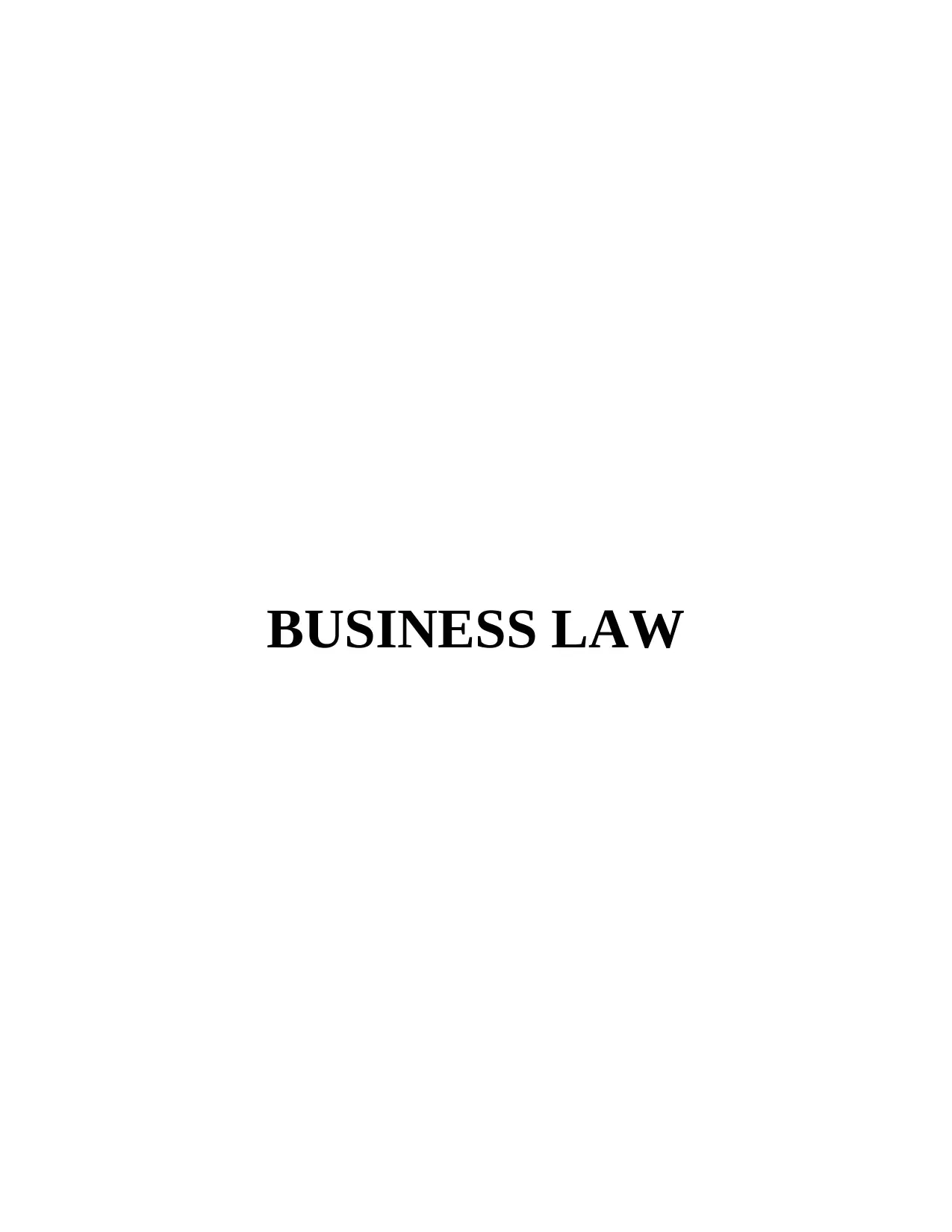
BUSINESS LAW
Paraphrase This Document
Need a fresh take? Get an instant paraphrase of this document with our AI Paraphraser
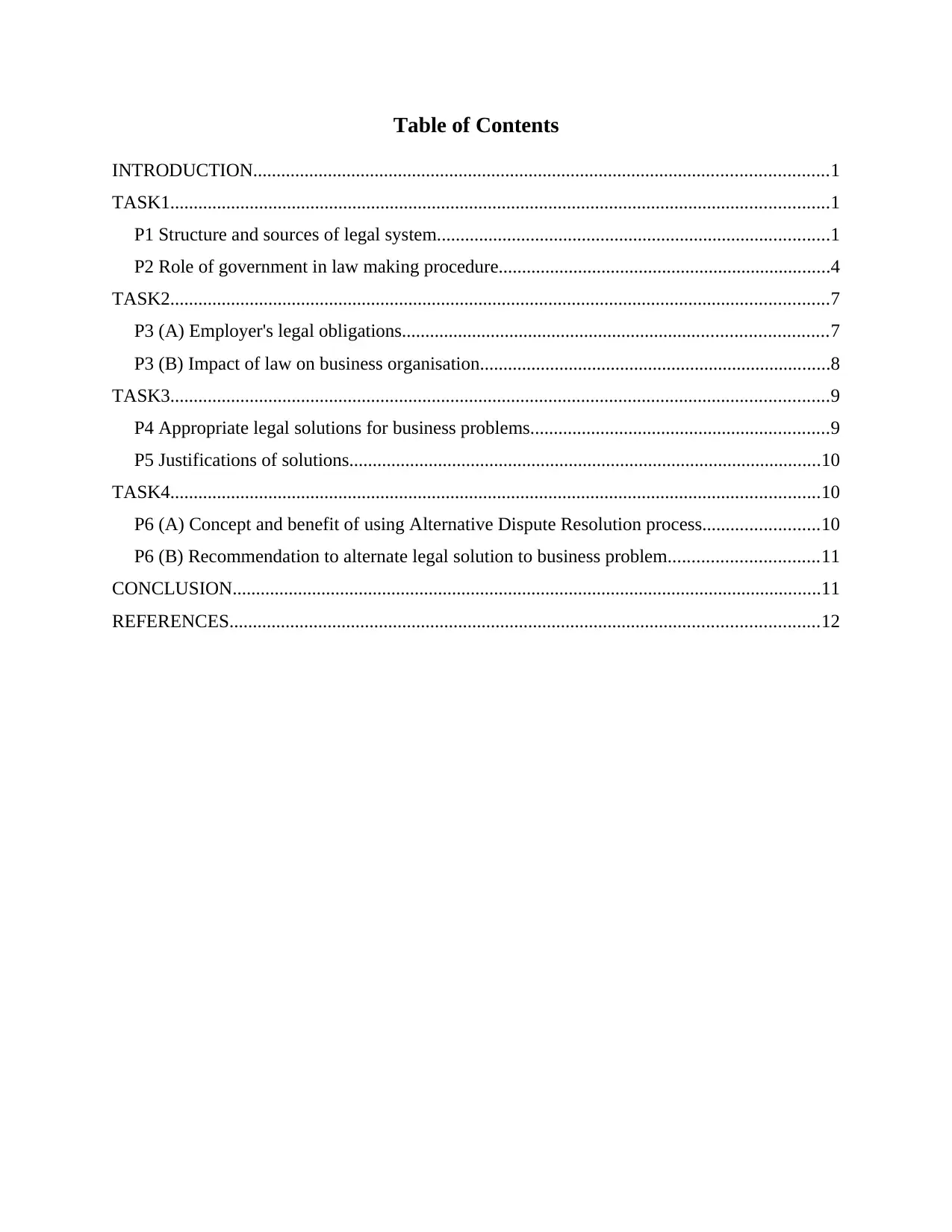
Table of Contents
INTRODUCTION...........................................................................................................................1
TASK1.............................................................................................................................................1
P1 Structure and sources of legal system....................................................................................1
P2 Role of government in law making procedure.......................................................................4
TASK2.............................................................................................................................................7
P3 (A) Employer's legal obligations...........................................................................................7
P3 (B) Impact of law on business organisation...........................................................................8
TASK3.............................................................................................................................................9
P4 Appropriate legal solutions for business problems................................................................9
P5 Justifications of solutions.....................................................................................................10
TASK4...........................................................................................................................................10
P6 (A) Concept and benefit of using Alternative Dispute Resolution process.........................10
P6 (B) Recommendation to alternate legal solution to business problem................................11
CONCLUSION..............................................................................................................................11
REFERENCES..............................................................................................................................12
INTRODUCTION...........................................................................................................................1
TASK1.............................................................................................................................................1
P1 Structure and sources of legal system....................................................................................1
P2 Role of government in law making procedure.......................................................................4
TASK2.............................................................................................................................................7
P3 (A) Employer's legal obligations...........................................................................................7
P3 (B) Impact of law on business organisation...........................................................................8
TASK3.............................................................................................................................................9
P4 Appropriate legal solutions for business problems................................................................9
P5 Justifications of solutions.....................................................................................................10
TASK4...........................................................................................................................................10
P6 (A) Concept and benefit of using Alternative Dispute Resolution process.........................10
P6 (B) Recommendation to alternate legal solution to business problem................................11
CONCLUSION..............................................................................................................................11
REFERENCES..............................................................................................................................12
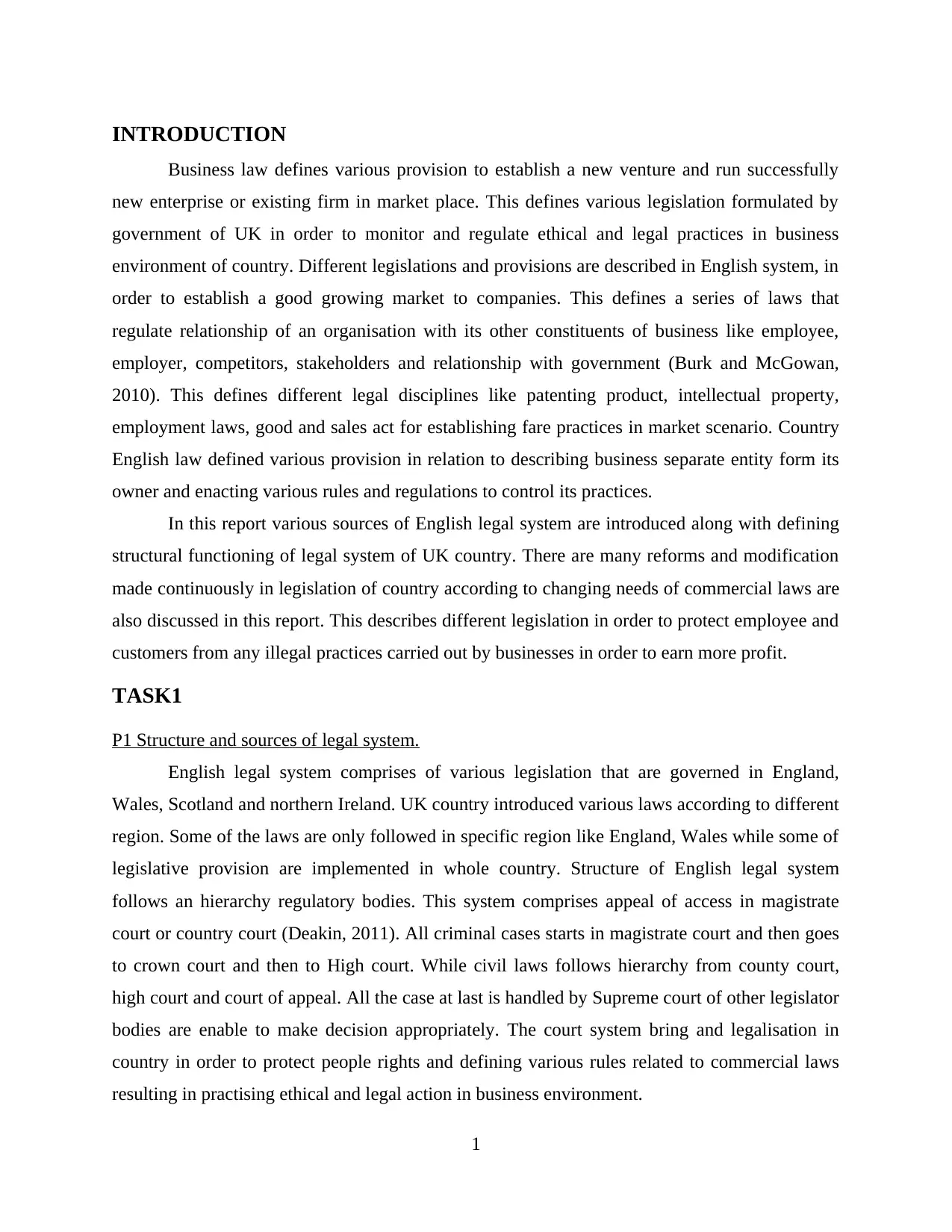
INTRODUCTION
Business law defines various provision to establish a new venture and run successfully
new enterprise or existing firm in market place. This defines various legislation formulated by
government of UK in order to monitor and regulate ethical and legal practices in business
environment of country. Different legislations and provisions are described in English system, in
order to establish a good growing market to companies. This defines a series of laws that
regulate relationship of an organisation with its other constituents of business like employee,
employer, competitors, stakeholders and relationship with government (Burk and McGowan,
2010). This defines different legal disciplines like patenting product, intellectual property,
employment laws, good and sales act for establishing fare practices in market scenario. Country
English law defined various provision in relation to describing business separate entity form its
owner and enacting various rules and regulations to control its practices.
In this report various sources of English legal system are introduced along with defining
structural functioning of legal system of UK country. There are many reforms and modification
made continuously in legislation of country according to changing needs of commercial laws are
also discussed in this report. This describes different legislation in order to protect employee and
customers from any illegal practices carried out by businesses in order to earn more profit.
TASK1
P1 Structure and sources of legal system.
English legal system comprises of various legislation that are governed in England,
Wales, Scotland and northern Ireland. UK country introduced various laws according to different
region. Some of the laws are only followed in specific region like England, Wales while some of
legislative provision are implemented in whole country. Structure of English legal system
follows an hierarchy regulatory bodies. This system comprises appeal of access in magistrate
court or country court (Deakin, 2011). All criminal cases starts in magistrate court and then goes
to crown court and then to High court. While civil laws follows hierarchy from county court,
high court and court of appeal. All the case at last is handled by Supreme court of other legislator
bodies are enable to make decision appropriately. The court system bring and legalisation in
country in order to protect people rights and defining various rules related to commercial laws
resulting in practising ethical and legal action in business environment.
1
Business law defines various provision to establish a new venture and run successfully
new enterprise or existing firm in market place. This defines various legislation formulated by
government of UK in order to monitor and regulate ethical and legal practices in business
environment of country. Different legislations and provisions are described in English system, in
order to establish a good growing market to companies. This defines a series of laws that
regulate relationship of an organisation with its other constituents of business like employee,
employer, competitors, stakeholders and relationship with government (Burk and McGowan,
2010). This defines different legal disciplines like patenting product, intellectual property,
employment laws, good and sales act for establishing fare practices in market scenario. Country
English law defined various provision in relation to describing business separate entity form its
owner and enacting various rules and regulations to control its practices.
In this report various sources of English legal system are introduced along with defining
structural functioning of legal system of UK country. There are many reforms and modification
made continuously in legislation of country according to changing needs of commercial laws are
also discussed in this report. This describes different legislation in order to protect employee and
customers from any illegal practices carried out by businesses in order to earn more profit.
TASK1
P1 Structure and sources of legal system.
English legal system comprises of various legislation that are governed in England,
Wales, Scotland and northern Ireland. UK country introduced various laws according to different
region. Some of the laws are only followed in specific region like England, Wales while some of
legislative provision are implemented in whole country. Structure of English legal system
follows an hierarchy regulatory bodies. This system comprises appeal of access in magistrate
court or country court (Deakin, 2011). All criminal cases starts in magistrate court and then goes
to crown court and then to High court. While civil laws follows hierarchy from county court,
high court and court of appeal. All the case at last is handled by Supreme court of other legislator
bodies are enable to make decision appropriately. The court system bring and legalisation in
country in order to protect people rights and defining various rules related to commercial laws
resulting in practising ethical and legal action in business environment.
1
⊘ This is a preview!⊘
Do you want full access?
Subscribe today to unlock all pages.

Trusted by 1+ million students worldwide
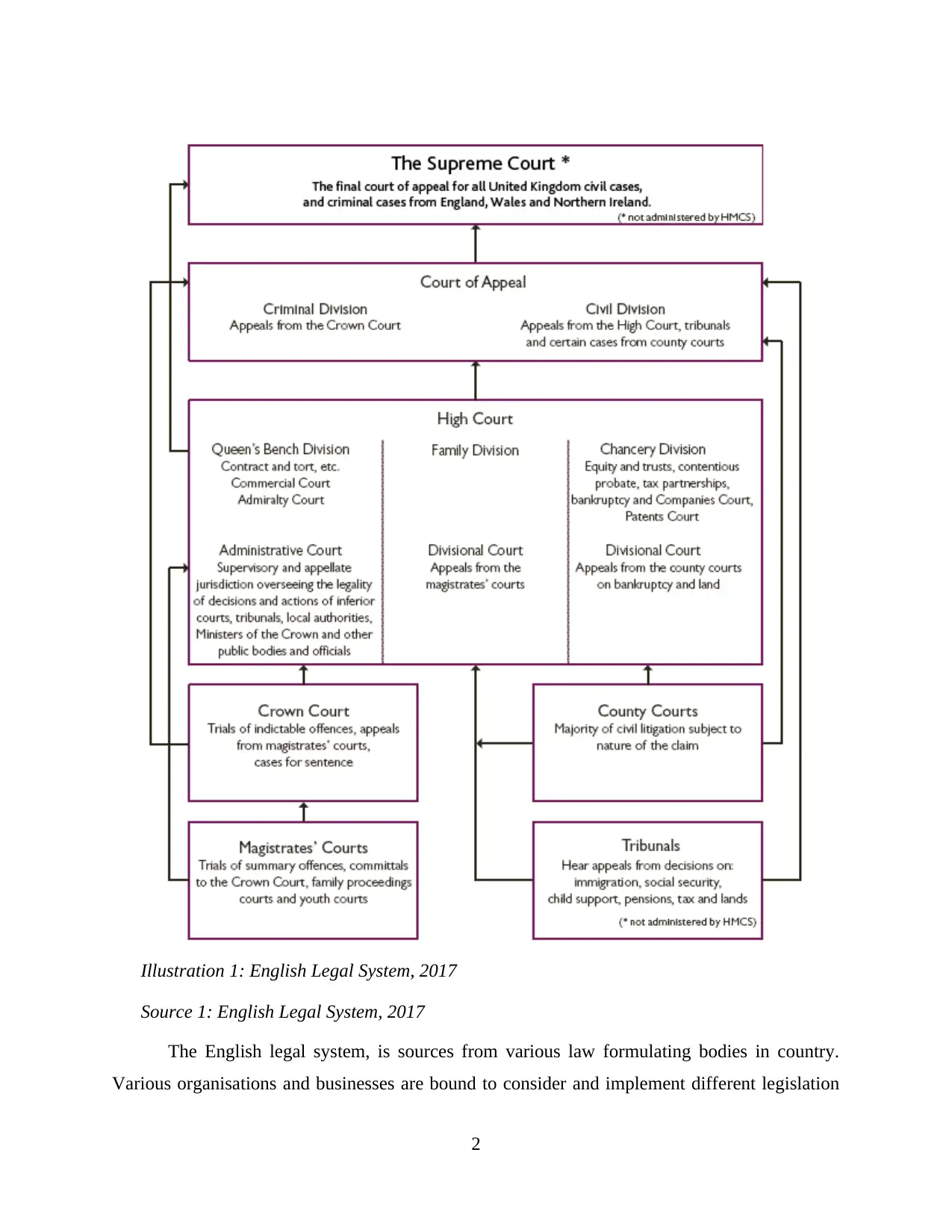
The English legal system, is sources from various law formulating bodies in country.
Various organisations and businesses are bound to consider and implement different legislation
2
Illustration 1: English Legal System, 2017
Source 1: English Legal System, 2017
Various organisations and businesses are bound to consider and implement different legislation
2
Illustration 1: English Legal System, 2017
Source 1: English Legal System, 2017
Paraphrase This Document
Need a fresh take? Get an instant paraphrase of this document with our AI Paraphraser
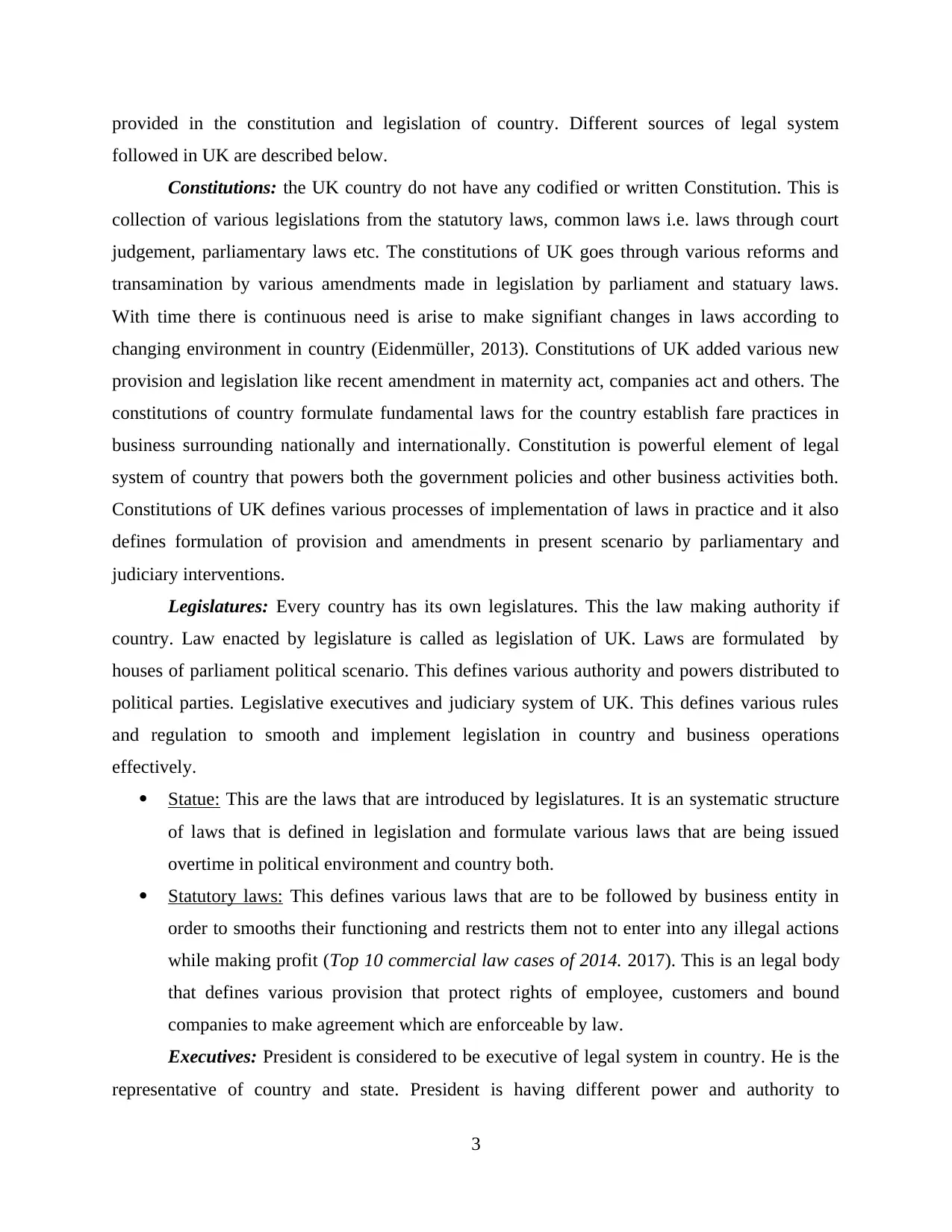
provided in the constitution and legislation of country. Different sources of legal system
followed in UK are described below.
Constitutions: the UK country do not have any codified or written Constitution. This is
collection of various legislations from the statutory laws, common laws i.e. laws through court
judgement, parliamentary laws etc. The constitutions of UK goes through various reforms and
transamination by various amendments made in legislation by parliament and statuary laws.
With time there is continuous need is arise to make signifiant changes in laws according to
changing environment in country (Eidenmüller, 2013). Constitutions of UK added various new
provision and legislation like recent amendment in maternity act, companies act and others. The
constitutions of country formulate fundamental laws for the country establish fare practices in
business surrounding nationally and internationally. Constitution is powerful element of legal
system of country that powers both the government policies and other business activities both.
Constitutions of UK defines various processes of implementation of laws in practice and it also
defines formulation of provision and amendments in present scenario by parliamentary and
judiciary interventions.
Legislatures: Every country has its own legislatures. This the law making authority if
country. Law enacted by legislature is called as legislation of UK. Laws are formulated by
houses of parliament political scenario. This defines various authority and powers distributed to
political parties. Legislative executives and judiciary system of UK. This defines various rules
and regulation to smooth and implement legislation in country and business operations
effectively.
Statue: This are the laws that are introduced by legislatures. It is an systematic structure
of laws that is defined in legislation and formulate various laws that are being issued
overtime in political environment and country both.
Statutory laws: This defines various laws that are to be followed by business entity in
order to smooths their functioning and restricts them not to enter into any illegal actions
while making profit (Top 10 commercial law cases of 2014. 2017). This is an legal body
that defines various provision that protect rights of employee, customers and bound
companies to make agreement which are enforceable by law.
Executives: President is considered to be executive of legal system in country. He is the
representative of country and state. President is having different power and authority to
3
followed in UK are described below.
Constitutions: the UK country do not have any codified or written Constitution. This is
collection of various legislations from the statutory laws, common laws i.e. laws through court
judgement, parliamentary laws etc. The constitutions of UK goes through various reforms and
transamination by various amendments made in legislation by parliament and statuary laws.
With time there is continuous need is arise to make signifiant changes in laws according to
changing environment in country (Eidenmüller, 2013). Constitutions of UK added various new
provision and legislation like recent amendment in maternity act, companies act and others. The
constitutions of country formulate fundamental laws for the country establish fare practices in
business surrounding nationally and internationally. Constitution is powerful element of legal
system of country that powers both the government policies and other business activities both.
Constitutions of UK defines various processes of implementation of laws in practice and it also
defines formulation of provision and amendments in present scenario by parliamentary and
judiciary interventions.
Legislatures: Every country has its own legislatures. This the law making authority if
country. Law enacted by legislature is called as legislation of UK. Laws are formulated by
houses of parliament political scenario. This defines various authority and powers distributed to
political parties. Legislative executives and judiciary system of UK. This defines various rules
and regulation to smooth and implement legislation in country and business operations
effectively.
Statue: This are the laws that are introduced by legislatures. It is an systematic structure
of laws that is defined in legislation and formulate various laws that are being issued
overtime in political environment and country both.
Statutory laws: This defines various laws that are to be followed by business entity in
order to smooths their functioning and restricts them not to enter into any illegal actions
while making profit (Top 10 commercial law cases of 2014. 2017). This is an legal body
that defines various provision that protect rights of employee, customers and bound
companies to make agreement which are enforceable by law.
Executives: President is considered to be executive of legal system in country. He is the
representative of country and state. President is having different power and authority to
3
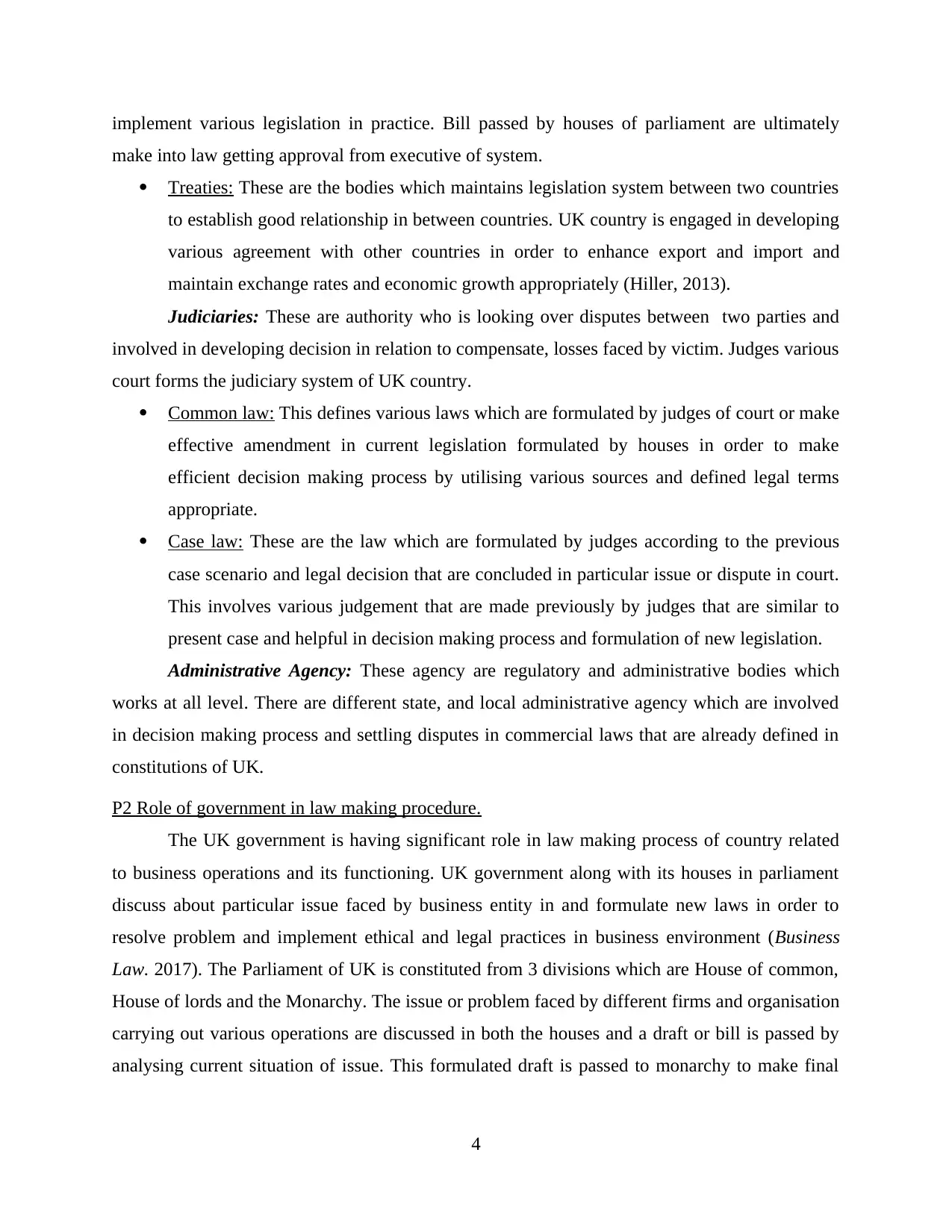
implement various legislation in practice. Bill passed by houses of parliament are ultimately
make into law getting approval from executive of system.
Treaties: These are the bodies which maintains legislation system between two countries
to establish good relationship in between countries. UK country is engaged in developing
various agreement with other countries in order to enhance export and import and
maintain exchange rates and economic growth appropriately (Hiller, 2013).
Judiciaries: These are authority who is looking over disputes between two parties and
involved in developing decision in relation to compensate, losses faced by victim. Judges various
court forms the judiciary system of UK country.
Common law: This defines various laws which are formulated by judges of court or make
effective amendment in current legislation formulated by houses in order to make
efficient decision making process by utilising various sources and defined legal terms
appropriate.
Case law: These are the law which are formulated by judges according to the previous
case scenario and legal decision that are concluded in particular issue or dispute in court.
This involves various judgement that are made previously by judges that are similar to
present case and helpful in decision making process and formulation of new legislation.
Administrative Agency: These agency are regulatory and administrative bodies which
works at all level. There are different state, and local administrative agency which are involved
in decision making process and settling disputes in commercial laws that are already defined in
constitutions of UK.
P2 Role of government in law making procedure.
The UK government is having significant role in law making process of country related
to business operations and its functioning. UK government along with its houses in parliament
discuss about particular issue faced by business entity in and formulate new laws in order to
resolve problem and implement ethical and legal practices in business environment (Business
Law. 2017). The Parliament of UK is constituted from 3 divisions which are House of common,
House of lords and the Monarchy. The issue or problem faced by different firms and organisation
carrying out various operations are discussed in both the houses and a draft or bill is passed by
analysing current situation of issue. This formulated draft is passed to monarchy to make final
4
make into law getting approval from executive of system.
Treaties: These are the bodies which maintains legislation system between two countries
to establish good relationship in between countries. UK country is engaged in developing
various agreement with other countries in order to enhance export and import and
maintain exchange rates and economic growth appropriately (Hiller, 2013).
Judiciaries: These are authority who is looking over disputes between two parties and
involved in developing decision in relation to compensate, losses faced by victim. Judges various
court forms the judiciary system of UK country.
Common law: This defines various laws which are formulated by judges of court or make
effective amendment in current legislation formulated by houses in order to make
efficient decision making process by utilising various sources and defined legal terms
appropriate.
Case law: These are the law which are formulated by judges according to the previous
case scenario and legal decision that are concluded in particular issue or dispute in court.
This involves various judgement that are made previously by judges that are similar to
present case and helpful in decision making process and formulation of new legislation.
Administrative Agency: These agency are regulatory and administrative bodies which
works at all level. There are different state, and local administrative agency which are involved
in decision making process and settling disputes in commercial laws that are already defined in
constitutions of UK.
P2 Role of government in law making procedure.
The UK government is having significant role in law making process of country related
to business operations and its functioning. UK government along with its houses in parliament
discuss about particular issue faced by business entity in and formulate new laws in order to
resolve problem and implement ethical and legal practices in business environment (Business
Law. 2017). The Parliament of UK is constituted from 3 divisions which are House of common,
House of lords and the Monarchy. The issue or problem faced by different firms and organisation
carrying out various operations are discussed in both the houses and a draft or bill is passed by
analysing current situation of issue. This formulated draft is passed to monarchy to make final
4
⊘ This is a preview!⊘
Do you want full access?
Subscribe today to unlock all pages.

Trusted by 1+ million students worldwide
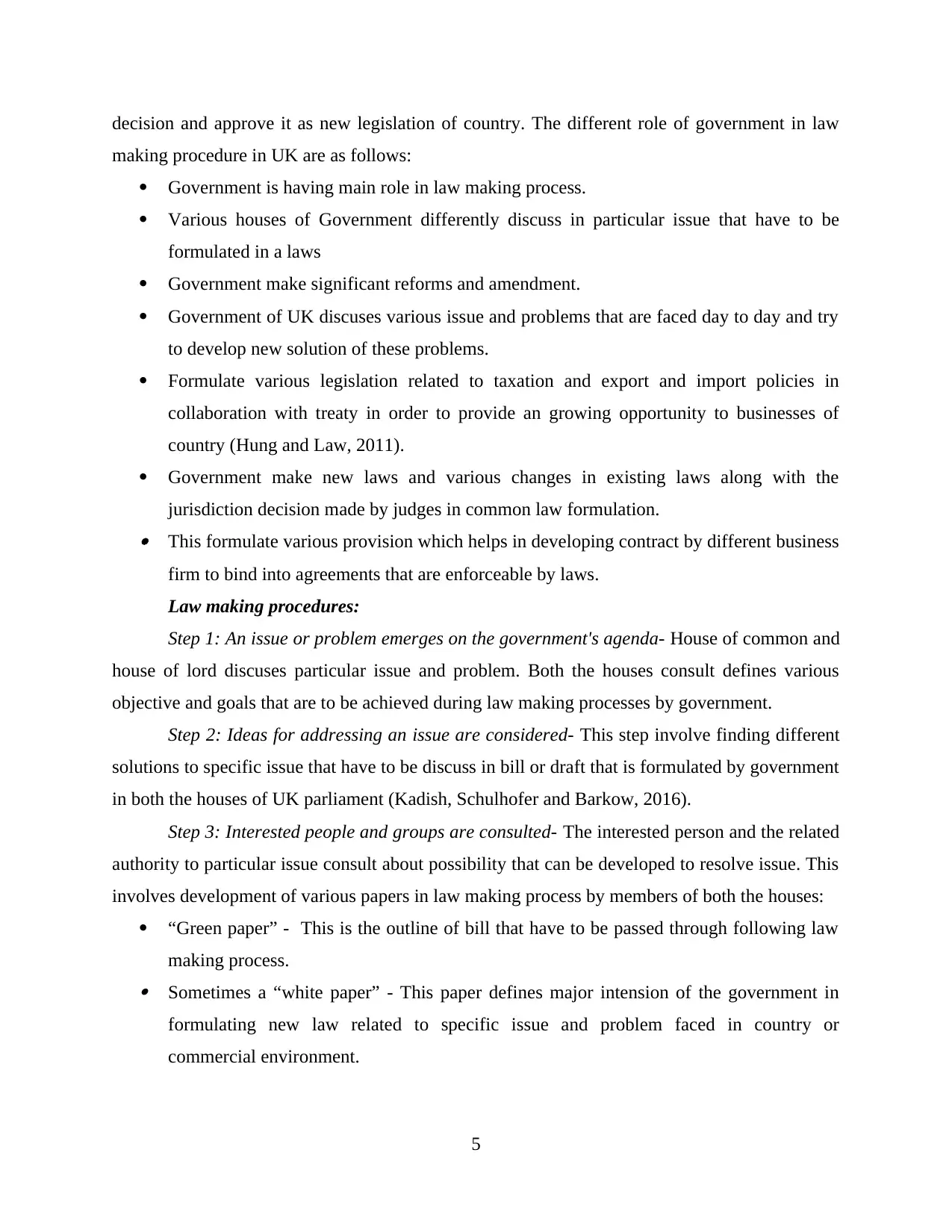
decision and approve it as new legislation of country. The different role of government in law
making procedure in UK are as follows:
Government is having main role in law making process.
Various houses of Government differently discuss in particular issue that have to be
formulated in a laws
Government make significant reforms and amendment.
Government of UK discuses various issue and problems that are faced day to day and try
to develop new solution of these problems.
Formulate various legislation related to taxation and export and import policies in
collaboration with treaty in order to provide an growing opportunity to businesses of
country (Hung and Law, 2011).
Government make new laws and various changes in existing laws along with the
jurisdiction decision made by judges in common law formulation. This formulate various provision which helps in developing contract by different business
firm to bind into agreements that are enforceable by laws.
Law making procedures:
Step 1: An issue or problem emerges on the government's agenda- House of common and
house of lord discuses particular issue and problem. Both the houses consult defines various
objective and goals that are to be achieved during law making processes by government.
Step 2: Ideas for addressing an issue are considered- This step involve finding different
solutions to specific issue that have to be discuss in bill or draft that is formulated by government
in both the houses of UK parliament (Kadish, Schulhofer and Barkow, 2016).
Step 3: Interested people and groups are consulted- The interested person and the related
authority to particular issue consult about possibility that can be developed to resolve issue. This
involves development of various papers in law making process by members of both the houses:
“Green paper” - This is the outline of bill that have to be passed through following law
making process. Sometimes a “white paper” - This paper defines major intension of the government in
formulating new law related to specific issue and problem faced in country or
commercial environment.
5
making procedure in UK are as follows:
Government is having main role in law making process.
Various houses of Government differently discuss in particular issue that have to be
formulated in a laws
Government make significant reforms and amendment.
Government of UK discuses various issue and problems that are faced day to day and try
to develop new solution of these problems.
Formulate various legislation related to taxation and export and import policies in
collaboration with treaty in order to provide an growing opportunity to businesses of
country (Hung and Law, 2011).
Government make new laws and various changes in existing laws along with the
jurisdiction decision made by judges in common law formulation. This formulate various provision which helps in developing contract by different business
firm to bind into agreements that are enforceable by laws.
Law making procedures:
Step 1: An issue or problem emerges on the government's agenda- House of common and
house of lord discuses particular issue and problem. Both the houses consult defines various
objective and goals that are to be achieved during law making processes by government.
Step 2: Ideas for addressing an issue are considered- This step involve finding different
solutions to specific issue that have to be discuss in bill or draft that is formulated by government
in both the houses of UK parliament (Kadish, Schulhofer and Barkow, 2016).
Step 3: Interested people and groups are consulted- The interested person and the related
authority to particular issue consult about possibility that can be developed to resolve issue. This
involves development of various papers in law making process by members of both the houses:
“Green paper” - This is the outline of bill that have to be passed through following law
making process. Sometimes a “white paper” - This paper defines major intension of the government in
formulating new law related to specific issue and problem faced in country or
commercial environment.
5
Paraphrase This Document
Need a fresh take? Get an instant paraphrase of this document with our AI Paraphraser
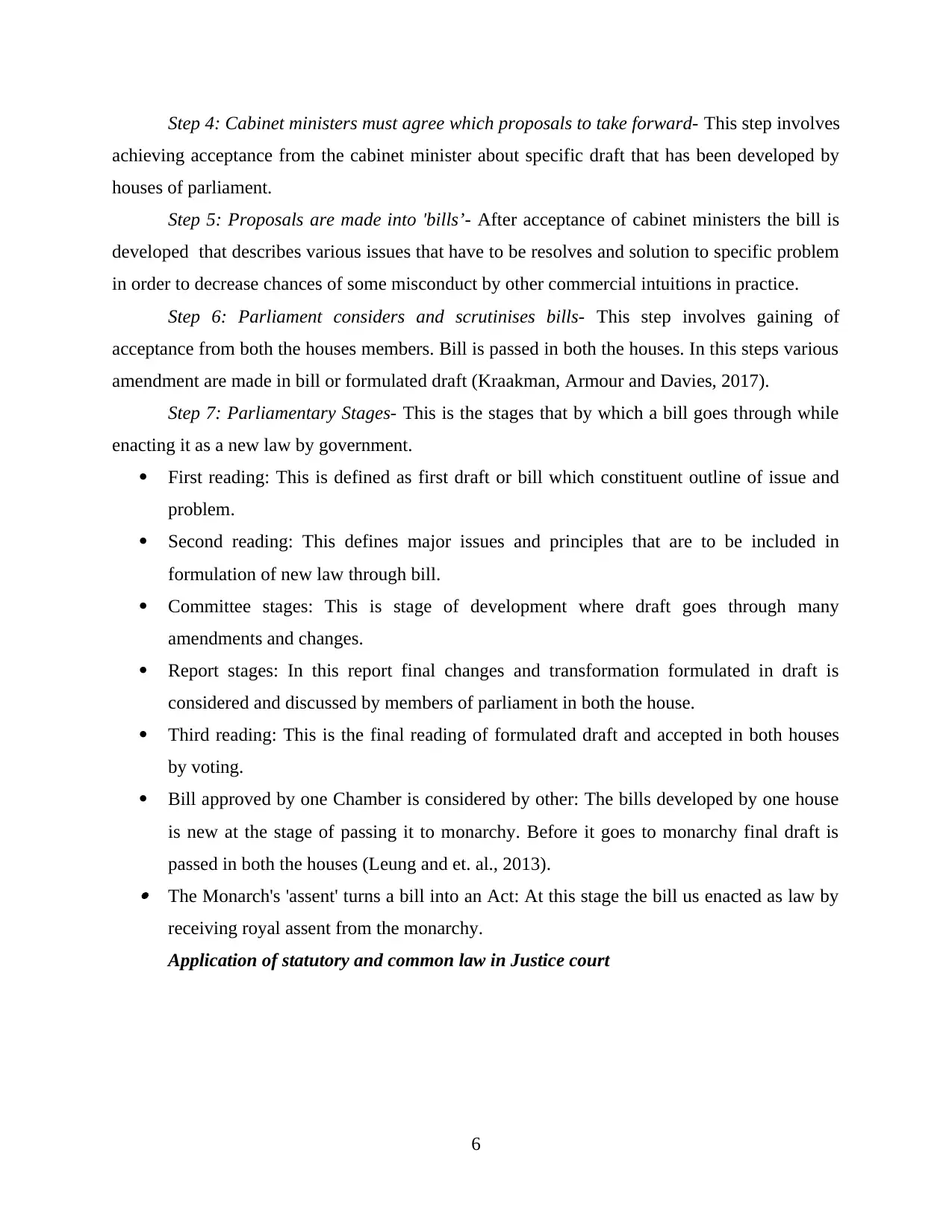
Step 4: Cabinet ministers must agree which proposals to take forward- This step involves
achieving acceptance from the cabinet minister about specific draft that has been developed by
houses of parliament.
Step 5: Proposals are made into 'bills’- After acceptance of cabinet ministers the bill is
developed that describes various issues that have to be resolves and solution to specific problem
in order to decrease chances of some misconduct by other commercial intuitions in practice.
Step 6: Parliament considers and scrutinises bills- This step involves gaining of
acceptance from both the houses members. Bill is passed in both the houses. In this steps various
amendment are made in bill or formulated draft (Kraakman, Armour and Davies, 2017).
Step 7: Parliamentary Stages- This is the stages that by which a bill goes through while
enacting it as a new law by government.
First reading: This is defined as first draft or bill which constituent outline of issue and
problem.
Second reading: This defines major issues and principles that are to be included in
formulation of new law through bill.
Committee stages: This is stage of development where draft goes through many
amendments and changes.
Report stages: In this report final changes and transformation formulated in draft is
considered and discussed by members of parliament in both the house.
Third reading: This is the final reading of formulated draft and accepted in both houses
by voting.
Bill approved by one Chamber is considered by other: The bills developed by one house
is new at the stage of passing it to monarchy. Before it goes to monarchy final draft is
passed in both the houses (Leung and et. al., 2013). The Monarch's 'assent' turns a bill into an Act: At this stage the bill us enacted as law by
receiving royal assent from the monarchy.
Application of statutory and common law in Justice court
6
achieving acceptance from the cabinet minister about specific draft that has been developed by
houses of parliament.
Step 5: Proposals are made into 'bills’- After acceptance of cabinet ministers the bill is
developed that describes various issues that have to be resolves and solution to specific problem
in order to decrease chances of some misconduct by other commercial intuitions in practice.
Step 6: Parliament considers and scrutinises bills- This step involves gaining of
acceptance from both the houses members. Bill is passed in both the houses. In this steps various
amendment are made in bill or formulated draft (Kraakman, Armour and Davies, 2017).
Step 7: Parliamentary Stages- This is the stages that by which a bill goes through while
enacting it as a new law by government.
First reading: This is defined as first draft or bill which constituent outline of issue and
problem.
Second reading: This defines major issues and principles that are to be included in
formulation of new law through bill.
Committee stages: This is stage of development where draft goes through many
amendments and changes.
Report stages: In this report final changes and transformation formulated in draft is
considered and discussed by members of parliament in both the house.
Third reading: This is the final reading of formulated draft and accepted in both houses
by voting.
Bill approved by one Chamber is considered by other: The bills developed by one house
is new at the stage of passing it to monarchy. Before it goes to monarchy final draft is
passed in both the houses (Leung and et. al., 2013). The Monarch's 'assent' turns a bill into an Act: At this stage the bill us enacted as law by
receiving royal assent from the monarchy.
Application of statutory and common law in Justice court
6
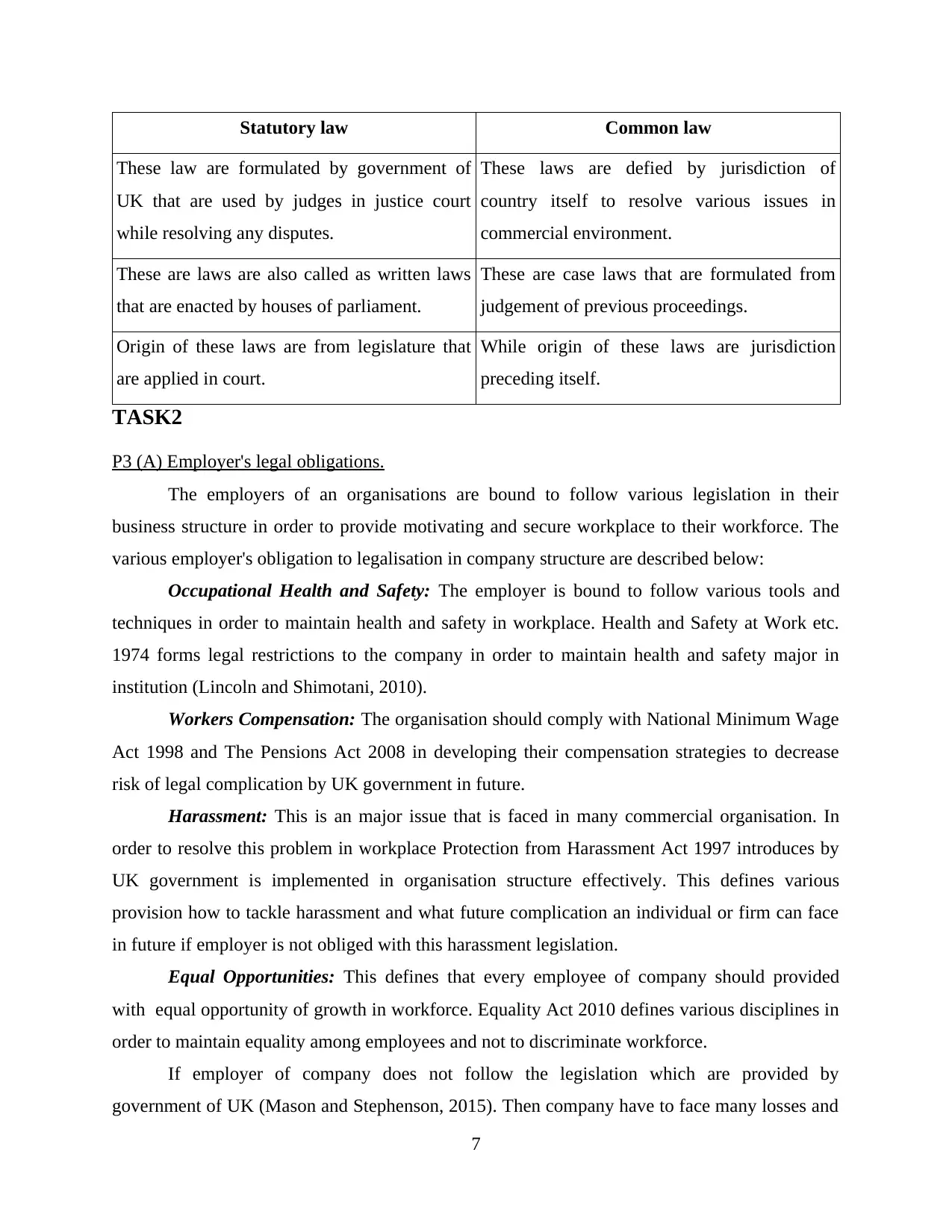
Statutory law Common law
These law are formulated by government of
UK that are used by judges in justice court
while resolving any disputes.
These laws are defied by jurisdiction of
country itself to resolve various issues in
commercial environment.
These are laws are also called as written laws
that are enacted by houses of parliament.
These are case laws that are formulated from
judgement of previous proceedings.
Origin of these laws are from legislature that
are applied in court.
While origin of these laws are jurisdiction
preceding itself.
TASK2
P3 (A) Employer's legal obligations.
The employers of an organisations are bound to follow various legislation in their
business structure in order to provide motivating and secure workplace to their workforce. The
various employer's obligation to legalisation in company structure are described below:
Occupational Health and Safety: The employer is bound to follow various tools and
techniques in order to maintain health and safety in workplace. Health and Safety at Work etc.
1974 forms legal restrictions to the company in order to maintain health and safety major in
institution (Lincoln and Shimotani, 2010).
Workers Compensation: The organisation should comply with National Minimum Wage
Act 1998 and The Pensions Act 2008 in developing their compensation strategies to decrease
risk of legal complication by UK government in future.
Harassment: This is an major issue that is faced in many commercial organisation. In
order to resolve this problem in workplace Protection from Harassment Act 1997 introduces by
UK government is implemented in organisation structure effectively. This defines various
provision how to tackle harassment and what future complication an individual or firm can face
in future if employer is not obliged with this harassment legislation.
Equal Opportunities: This defines that every employee of company should provided
with equal opportunity of growth in workforce. Equality Act 2010 defines various disciplines in
order to maintain equality among employees and not to discriminate workforce.
If employer of company does not follow the legislation which are provided by
government of UK (Mason and Stephenson, 2015). Then company have to face many losses and
7
These law are formulated by government of
UK that are used by judges in justice court
while resolving any disputes.
These laws are defied by jurisdiction of
country itself to resolve various issues in
commercial environment.
These are laws are also called as written laws
that are enacted by houses of parliament.
These are case laws that are formulated from
judgement of previous proceedings.
Origin of these laws are from legislature that
are applied in court.
While origin of these laws are jurisdiction
preceding itself.
TASK2
P3 (A) Employer's legal obligations.
The employers of an organisations are bound to follow various legislation in their
business structure in order to provide motivating and secure workplace to their workforce. The
various employer's obligation to legalisation in company structure are described below:
Occupational Health and Safety: The employer is bound to follow various tools and
techniques in order to maintain health and safety in workplace. Health and Safety at Work etc.
1974 forms legal restrictions to the company in order to maintain health and safety major in
institution (Lincoln and Shimotani, 2010).
Workers Compensation: The organisation should comply with National Minimum Wage
Act 1998 and The Pensions Act 2008 in developing their compensation strategies to decrease
risk of legal complication by UK government in future.
Harassment: This is an major issue that is faced in many commercial organisation. In
order to resolve this problem in workplace Protection from Harassment Act 1997 introduces by
UK government is implemented in organisation structure effectively. This defines various
provision how to tackle harassment and what future complication an individual or firm can face
in future if employer is not obliged with this harassment legislation.
Equal Opportunities: This defines that every employee of company should provided
with equal opportunity of growth in workforce. Equality Act 2010 defines various disciplines in
order to maintain equality among employees and not to discriminate workforce.
If employer of company does not follow the legislation which are provided by
government of UK (Mason and Stephenson, 2015). Then company have to face many losses and
7
⊘ This is a preview!⊘
Do you want full access?
Subscribe today to unlock all pages.

Trusted by 1+ million students worldwide
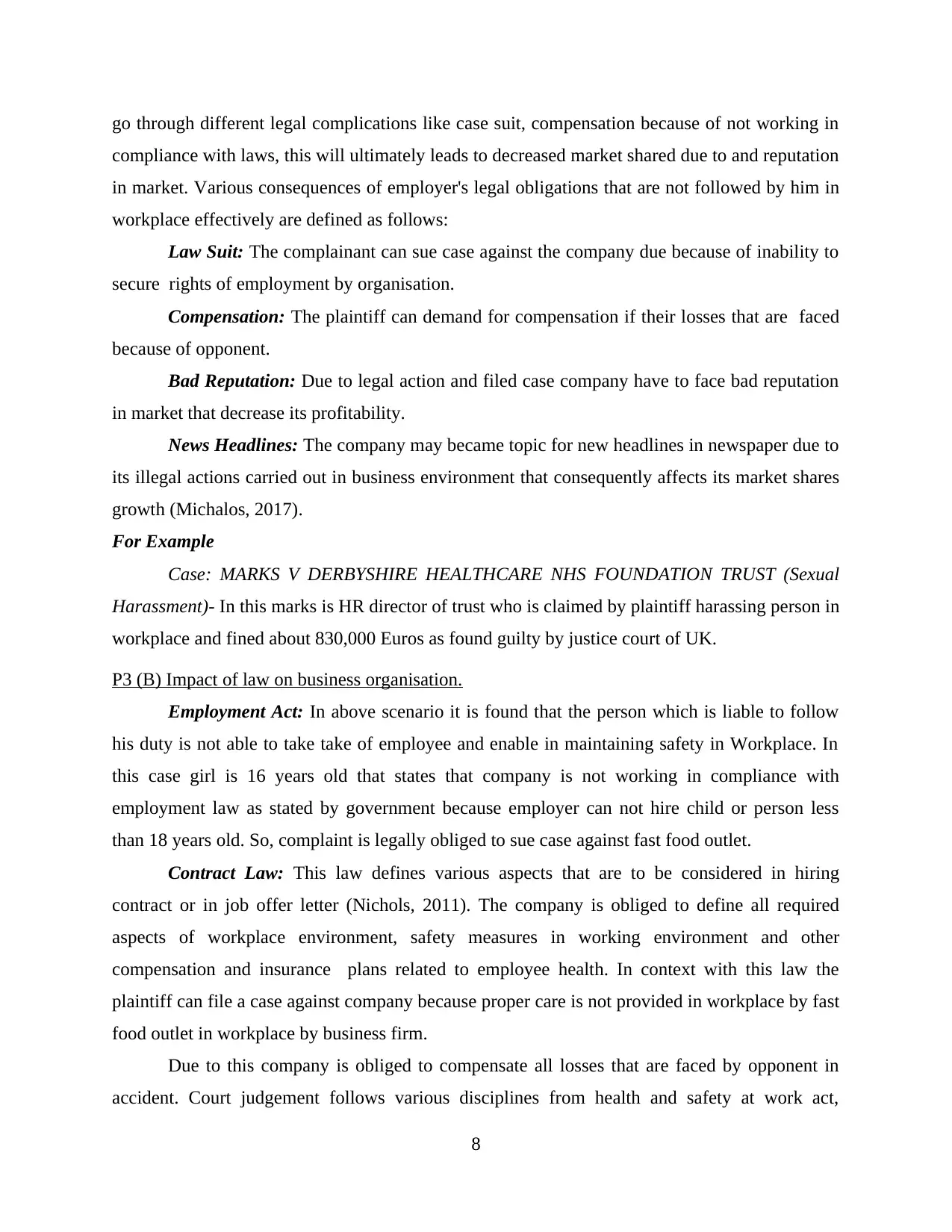
go through different legal complications like case suit, compensation because of not working in
compliance with laws, this will ultimately leads to decreased market shared due to and reputation
in market. Various consequences of employer's legal obligations that are not followed by him in
workplace effectively are defined as follows:
Law Suit: The complainant can sue case against the company due because of inability to
secure rights of employment by organisation.
Compensation: The plaintiff can demand for compensation if their losses that are faced
because of opponent.
Bad Reputation: Due to legal action and filed case company have to face bad reputation
in market that decrease its profitability.
News Headlines: The company may became topic for new headlines in newspaper due to
its illegal actions carried out in business environment that consequently affects its market shares
growth (Michalos, 2017).
For Example
Case: MARKS V DERBYSHIRE HEALTHCARE NHS FOUNDATION TRUST (Sexual
Harassment)- In this marks is HR director of trust who is claimed by plaintiff harassing person in
workplace and fined about 830,000 Euros as found guilty by justice court of UK.
P3 (B) Impact of law on business organisation.
Employment Act: In above scenario it is found that the person which is liable to follow
his duty is not able to take take of employee and enable in maintaining safety in Workplace. In
this case girl is 16 years old that states that company is not working in compliance with
employment law as stated by government because employer can not hire child or person less
than 18 years old. So, complaint is legally obliged to sue case against fast food outlet.
Contract Law: This law defines various aspects that are to be considered in hiring
contract or in job offer letter (Nichols, 2011). The company is obliged to define all required
aspects of workplace environment, safety measures in working environment and other
compensation and insurance plans related to employee health. In context with this law the
plaintiff can file a case against company because proper care is not provided in workplace by fast
food outlet in workplace by business firm.
Due to this company is obliged to compensate all losses that are faced by opponent in
accident. Court judgement follows various disciplines from health and safety at work act,
8
compliance with laws, this will ultimately leads to decreased market shared due to and reputation
in market. Various consequences of employer's legal obligations that are not followed by him in
workplace effectively are defined as follows:
Law Suit: The complainant can sue case against the company due because of inability to
secure rights of employment by organisation.
Compensation: The plaintiff can demand for compensation if their losses that are faced
because of opponent.
Bad Reputation: Due to legal action and filed case company have to face bad reputation
in market that decrease its profitability.
News Headlines: The company may became topic for new headlines in newspaper due to
its illegal actions carried out in business environment that consequently affects its market shares
growth (Michalos, 2017).
For Example
Case: MARKS V DERBYSHIRE HEALTHCARE NHS FOUNDATION TRUST (Sexual
Harassment)- In this marks is HR director of trust who is claimed by plaintiff harassing person in
workplace and fined about 830,000 Euros as found guilty by justice court of UK.
P3 (B) Impact of law on business organisation.
Employment Act: In above scenario it is found that the person which is liable to follow
his duty is not able to take take of employee and enable in maintaining safety in Workplace. In
this case girl is 16 years old that states that company is not working in compliance with
employment law as stated by government because employer can not hire child or person less
than 18 years old. So, complaint is legally obliged to sue case against fast food outlet.
Contract Law: This law defines various aspects that are to be considered in hiring
contract or in job offer letter (Nichols, 2011). The company is obliged to define all required
aspects of workplace environment, safety measures in working environment and other
compensation and insurance plans related to employee health. In context with this law the
plaintiff can file a case against company because proper care is not provided in workplace by fast
food outlet in workplace by business firm.
Due to this company is obliged to compensate all losses that are faced by opponent in
accident. Court judgement follows various disciplines from health and safety at work act,
8
Paraphrase This Document
Need a fresh take? Get an instant paraphrase of this document with our AI Paraphraser
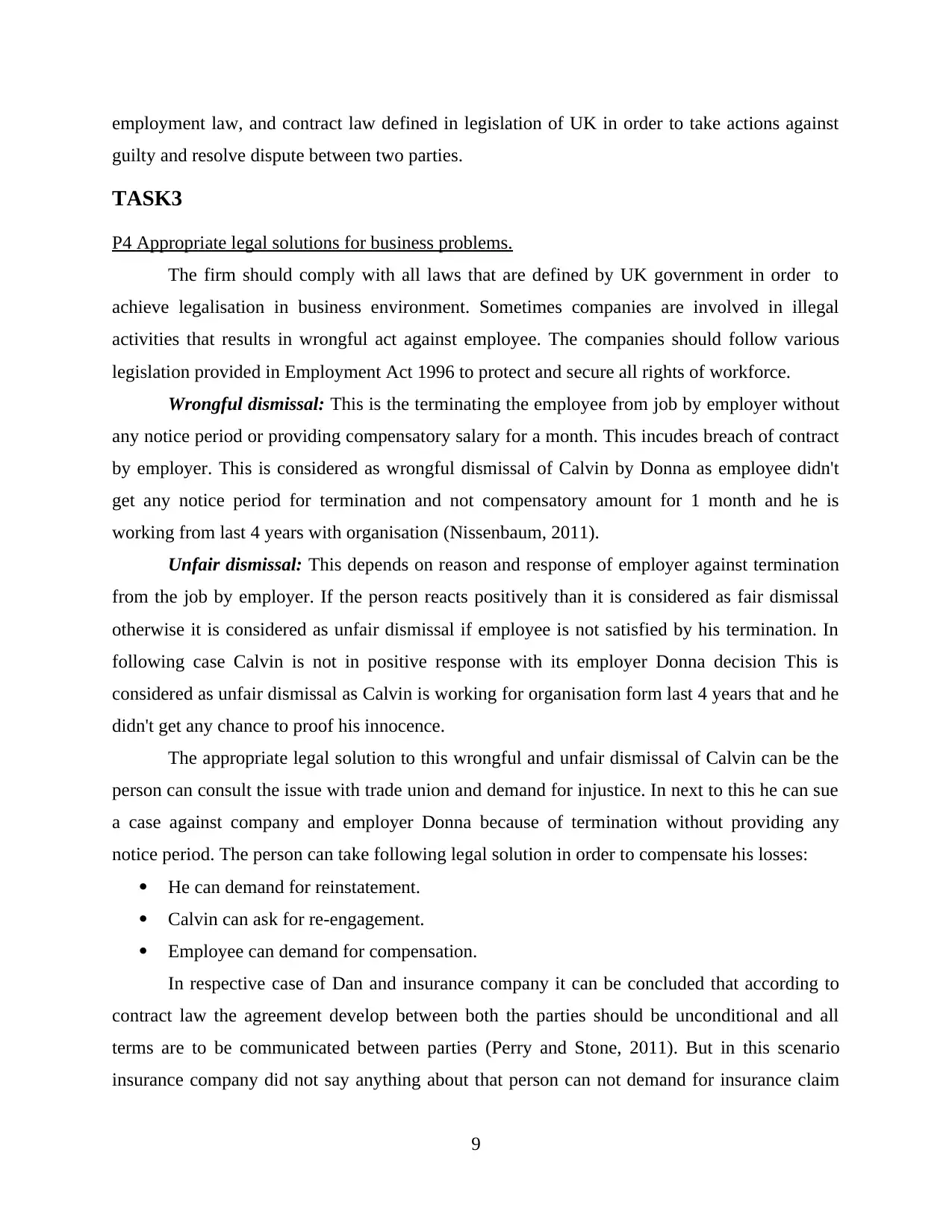
employment law, and contract law defined in legislation of UK in order to take actions against
guilty and resolve dispute between two parties.
TASK3
P4 Appropriate legal solutions for business problems.
The firm should comply with all laws that are defined by UK government in order to
achieve legalisation in business environment. Sometimes companies are involved in illegal
activities that results in wrongful act against employee. The companies should follow various
legislation provided in Employment Act 1996 to protect and secure all rights of workforce.
Wrongful dismissal: This is the terminating the employee from job by employer without
any notice period or providing compensatory salary for a month. This incudes breach of contract
by employer. This is considered as wrongful dismissal of Calvin by Donna as employee didn't
get any notice period for termination and not compensatory amount for 1 month and he is
working from last 4 years with organisation (Nissenbaum, 2011).
Unfair dismissal: This depends on reason and response of employer against termination
from the job by employer. If the person reacts positively than it is considered as fair dismissal
otherwise it is considered as unfair dismissal if employee is not satisfied by his termination. In
following case Calvin is not in positive response with its employer Donna decision This is
considered as unfair dismissal as Calvin is working for organisation form last 4 years that and he
didn't get any chance to proof his innocence.
The appropriate legal solution to this wrongful and unfair dismissal of Calvin can be the
person can consult the issue with trade union and demand for injustice. In next to this he can sue
a case against company and employer Donna because of termination without providing any
notice period. The person can take following legal solution in order to compensate his losses:
He can demand for reinstatement.
Calvin can ask for re-engagement.
Employee can demand for compensation.
In respective case of Dan and insurance company it can be concluded that according to
contract law the agreement develop between both the parties should be unconditional and all
terms are to be communicated between parties (Perry and Stone, 2011). But in this scenario
insurance company did not say anything about that person can not demand for insurance claim
9
guilty and resolve dispute between two parties.
TASK3
P4 Appropriate legal solutions for business problems.
The firm should comply with all laws that are defined by UK government in order to
achieve legalisation in business environment. Sometimes companies are involved in illegal
activities that results in wrongful act against employee. The companies should follow various
legislation provided in Employment Act 1996 to protect and secure all rights of workforce.
Wrongful dismissal: This is the terminating the employee from job by employer without
any notice period or providing compensatory salary for a month. This incudes breach of contract
by employer. This is considered as wrongful dismissal of Calvin by Donna as employee didn't
get any notice period for termination and not compensatory amount for 1 month and he is
working from last 4 years with organisation (Nissenbaum, 2011).
Unfair dismissal: This depends on reason and response of employer against termination
from the job by employer. If the person reacts positively than it is considered as fair dismissal
otherwise it is considered as unfair dismissal if employee is not satisfied by his termination. In
following case Calvin is not in positive response with its employer Donna decision This is
considered as unfair dismissal as Calvin is working for organisation form last 4 years that and he
didn't get any chance to proof his innocence.
The appropriate legal solution to this wrongful and unfair dismissal of Calvin can be the
person can consult the issue with trade union and demand for injustice. In next to this he can sue
a case against company and employer Donna because of termination without providing any
notice period. The person can take following legal solution in order to compensate his losses:
He can demand for reinstatement.
Calvin can ask for re-engagement.
Employee can demand for compensation.
In respective case of Dan and insurance company it can be concluded that according to
contract law the agreement develop between both the parties should be unconditional and all
terms are to be communicated between parties (Perry and Stone, 2011). But in this scenario
insurance company did not say anything about that person can not demand for insurance claim
9
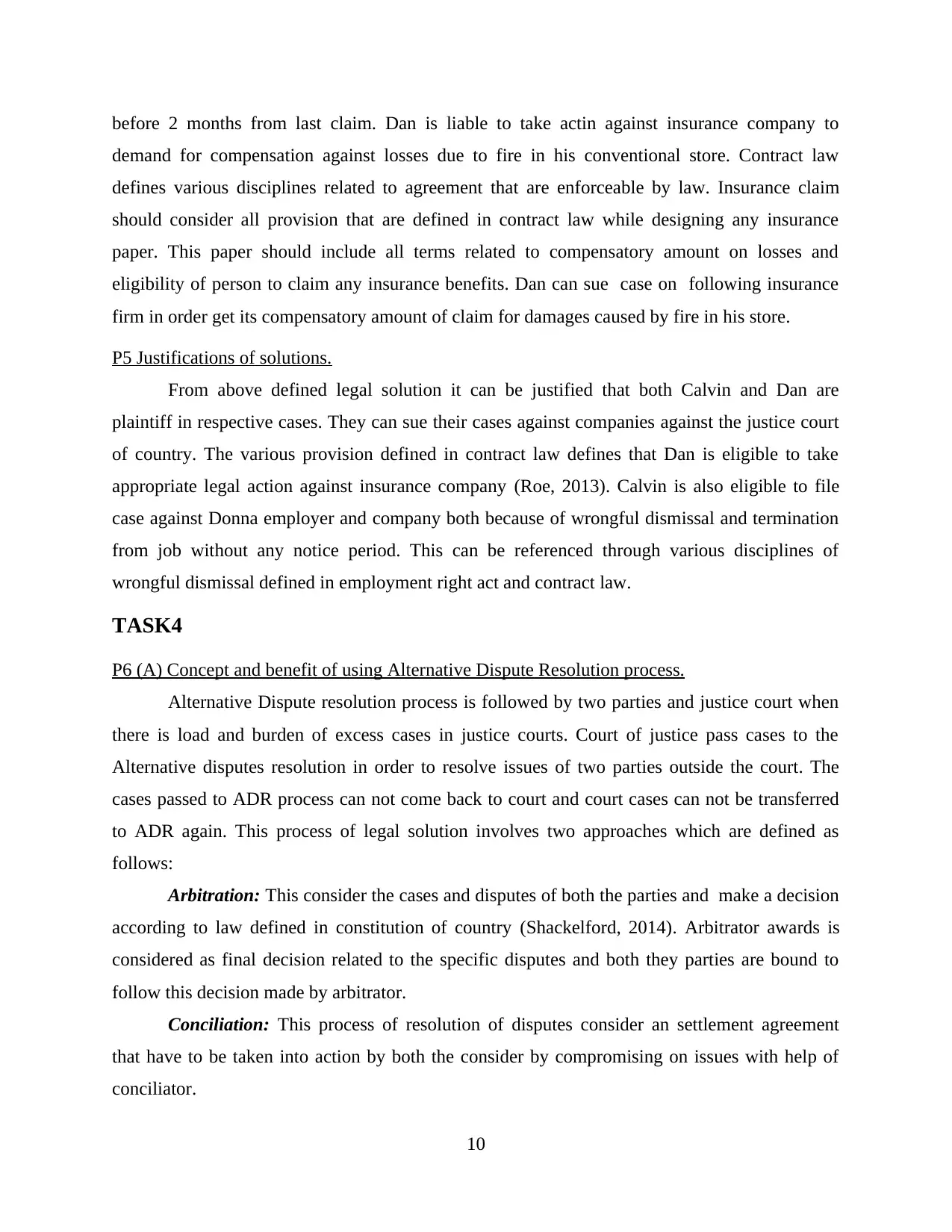
before 2 months from last claim. Dan is liable to take actin against insurance company to
demand for compensation against losses due to fire in his conventional store. Contract law
defines various disciplines related to agreement that are enforceable by law. Insurance claim
should consider all provision that are defined in contract law while designing any insurance
paper. This paper should include all terms related to compensatory amount on losses and
eligibility of person to claim any insurance benefits. Dan can sue case on following insurance
firm in order get its compensatory amount of claim for damages caused by fire in his store.
P5 Justifications of solutions.
From above defined legal solution it can be justified that both Calvin and Dan are
plaintiff in respective cases. They can sue their cases against companies against the justice court
of country. The various provision defined in contract law defines that Dan is eligible to take
appropriate legal action against insurance company (Roe, 2013). Calvin is also eligible to file
case against Donna employer and company both because of wrongful dismissal and termination
from job without any notice period. This can be referenced through various disciplines of
wrongful dismissal defined in employment right act and contract law.
TASK4
P6 (A) Concept and benefit of using Alternative Dispute Resolution process.
Alternative Dispute resolution process is followed by two parties and justice court when
there is load and burden of excess cases in justice courts. Court of justice pass cases to the
Alternative disputes resolution in order to resolve issues of two parties outside the court. The
cases passed to ADR process can not come back to court and court cases can not be transferred
to ADR again. This process of legal solution involves two approaches which are defined as
follows:
Arbitration: This consider the cases and disputes of both the parties and make a decision
according to law defined in constitution of country (Shackelford, 2014). Arbitrator awards is
considered as final decision related to the specific disputes and both they parties are bound to
follow this decision made by arbitrator.
Conciliation: This process of resolution of disputes consider an settlement agreement
that have to be taken into action by both the consider by compromising on issues with help of
conciliator.
10
demand for compensation against losses due to fire in his conventional store. Contract law
defines various disciplines related to agreement that are enforceable by law. Insurance claim
should consider all provision that are defined in contract law while designing any insurance
paper. This paper should include all terms related to compensatory amount on losses and
eligibility of person to claim any insurance benefits. Dan can sue case on following insurance
firm in order get its compensatory amount of claim for damages caused by fire in his store.
P5 Justifications of solutions.
From above defined legal solution it can be justified that both Calvin and Dan are
plaintiff in respective cases. They can sue their cases against companies against the justice court
of country. The various provision defined in contract law defines that Dan is eligible to take
appropriate legal action against insurance company (Roe, 2013). Calvin is also eligible to file
case against Donna employer and company both because of wrongful dismissal and termination
from job without any notice period. This can be referenced through various disciplines of
wrongful dismissal defined in employment right act and contract law.
TASK4
P6 (A) Concept and benefit of using Alternative Dispute Resolution process.
Alternative Dispute resolution process is followed by two parties and justice court when
there is load and burden of excess cases in justice courts. Court of justice pass cases to the
Alternative disputes resolution in order to resolve issues of two parties outside the court. The
cases passed to ADR process can not come back to court and court cases can not be transferred
to ADR again. This process of legal solution involves two approaches which are defined as
follows:
Arbitration: This consider the cases and disputes of both the parties and make a decision
according to law defined in constitution of country (Shackelford, 2014). Arbitrator awards is
considered as final decision related to the specific disputes and both they parties are bound to
follow this decision made by arbitrator.
Conciliation: This process of resolution of disputes consider an settlement agreement
that have to be taken into action by both the consider by compromising on issues with help of
conciliator.
10
⊘ This is a preview!⊘
Do you want full access?
Subscribe today to unlock all pages.

Trusted by 1+ million students worldwide
1 out of 14
Related Documents
Your All-in-One AI-Powered Toolkit for Academic Success.
+13062052269
info@desklib.com
Available 24*7 on WhatsApp / Email
![[object Object]](/_next/static/media/star-bottom.7253800d.svg)
Unlock your academic potential
Copyright © 2020–2025 A2Z Services. All Rights Reserved. Developed and managed by ZUCOL.





